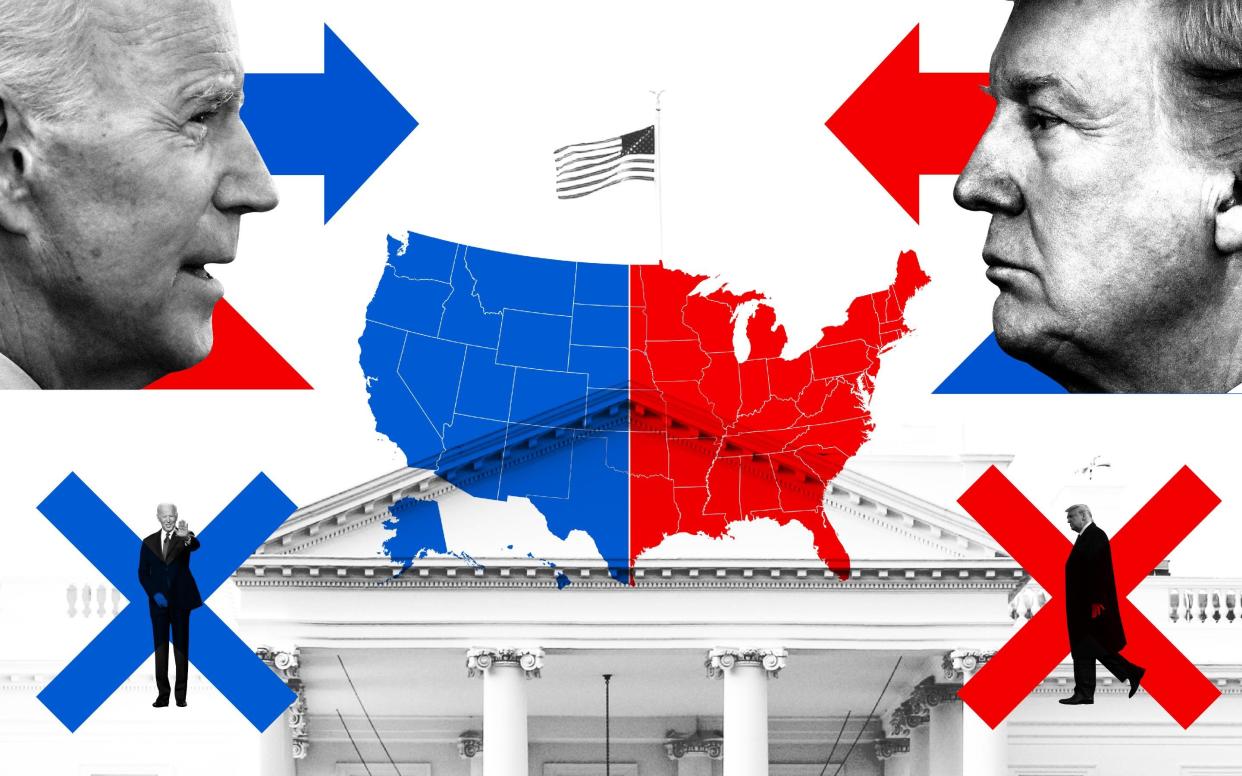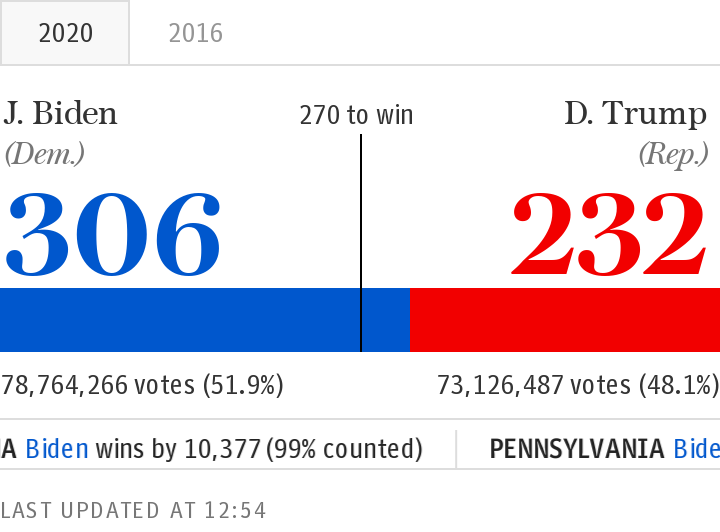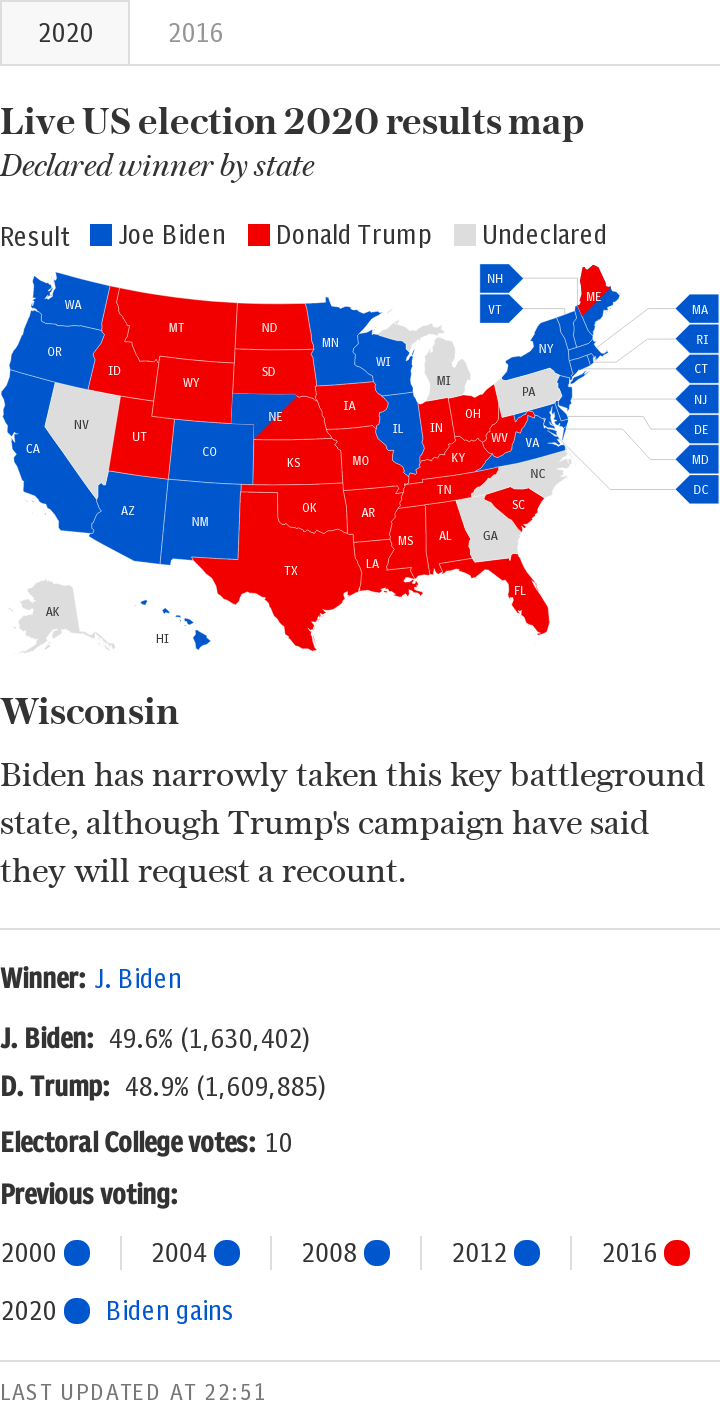US election results and maps 2020: Joe Biden wins US election with all states called

- Oops!Something went wrong.Please try again later.

Joe Biden has kicked off his move to the White House after being projected to win 306 electoral college votes, far more than that 270 needed to become the next President of the United States of America, with Donald Trump claiming 232.
On Friday, the state of Georgia was called for Mr Biden, while North Carolina was called in favour of Mr Trump.
Mr Biden set his transition in motion by launching a website, BuildBackBetter.com, after beating Mr Trump in the final key battlegrounds of the election, marking the end of a tense but protracted race for the White House.
Victory for Biden came after clinching Pennsylvania and Nevada, where vote counts continued for days after election night failed to deliver a clear winner.
Georgia, one of five states flipped by Mr Biden after going into Mr Trump's column last time around, hadn't been won by a Democrat since Bill Clinton in 1992.
Mr Biden is currently up by some 14,000 votes, and a hand recount is expected to be completed next week. Audits of state-wide elections never bring the kind of reversal that Mr Trump would need to change the result.
In traditionally-Republican North Carolina, a drive to get out black voters by Democrats was not enough to overcome Trump's hugely loyal base of white, non-college-educated men and rural voters.
The election saw the biggest voter turn out since 1968, with over 150 million votes tallied, and an Associated Press analysis highlighted that some of the biggest turnout increases occurred in states that liberalized their mail-voting rules.
Mr Trump continued to sow doubt about the election results, with baseless claims of voter fraud, and threatened legal action despite mainstream news outlets calling the election in Mr Biden's favour.
He tweeted on November 8, "Since when does the Lamestream Media call who our next president will be?"

The key swing states of US election
Biden’s win bookends an election that went down to the wire in key swing states, after neither Biden or Trump delivered a knock-out blow early on in the night of November 3. Results night began as expected, with both candidates racking up wins in safe states like New York and Vermont for Biden and Tennessee and Kentucky for Trump. Yet hopes of the race yielding a definitive result soon faded away as Trump won the swing state of Florida, a key indication the sitting President’s support was holding up better than expected.

Likewise Biden failed to win in Republican strongholds tipped to flip in 2020 like Texas, which Trump won with a margin of six per cent. This represented the final nail in the coffin for hopes of a Biden landslide, which had been suggested by some pre-election forecasts.

Instead America tensely waited days to hear who their next President would be as a handful of key battleground states began to count.
Confidence of a Biden win first emerged after he took the Rust Belt states of Wisconsin and Michigan, which were both key to Trump’s victory in 2016. The two states together put Biden tantalisingly close to the 270 electoral college votes needed to win.
Meanwhile Biden also performed strongly in Arizona, a previously red state that the Democrats have been trying to turn blue since the 1990s. Fox News and Associated Press called the state for Biden on election night itself, but tightening margins led other outlets, including The Telegraph, to hold off while the outcome was so uncertain.
But the key moment for Biden came as he overtook Trump in the battleground states of Pennsylvania, Arizona, Nevada and Georgia. After a drawn-out count process that had seen Trump ahead since results night, Biden inched in front and his overall lead slowly increased, granting him enough electoral college votes to put him over the winning threshold.
The secretary of state, Mike Pompeo, announced there will be a recount of ballots in Georgia, after Mr Biden swung the state by only 0.3 per cent.

The main takeaways of the 2020 election
The 2020 US election was already set to smash records, with 100 million Americans voting early either in-person or by mail before polling stations opened on November 3.
Votes are still being counted, but the US election has officially hit the highest turnout since 1968, according to data from the Associated Press and the United States Elections Project.
As of November 8, the tallied votes accounted for 62 per cent of the eligible voting-age population in the US.
It is being seen as a testament to the impact of broadening the timeframe and ways in which people can vote.
66.4 per cent of eligible voters turned out or cast mail-in ballots, according to the US Election Project: the highest rate since 1900.
An Associated Press analysis shows that some of the biggest turnout increases to date occurred in states that liberalized their mail-voting rules. In Montana and Vermont, turnout rose by more than 10 percentage points and more than 9 percentage points, respectively, over the previous presidential election.
This high level of turnout has helped boost Biden into the record books, after he won over 77 million votes - the highest total number of votes ever received by a presidential candidate in US history.
Hawaii saw the biggest turnout increase, a more than 14 percentage point jump so far.
Texas, which did not expand mail voting but gave voters extra time to cast early ballots in person, saw a more than 9 percentage point increase in turnout, moving from 50 percent to 59 percent of its citizen voting-age population going to the polls.
In terms of the direction of the race, early indications suggest the polls may have underestimated the Hispanic support Trump could wield, and dented Biden’s hopes of a landslide.
The 2016 election saw 28 per cent of Hispanic men vote for Trump, but according to exit poll data that number rose to 36 per cent this year, while support among Hispanic women remained steady.
But while Trump's base four years ago was cemented among white men, his support among the demographic appears to have waned this year.
In 2016, 62 per cent of white men voted for Trump, while exit polls suggest that number has fallen to 58 per cent this year.
Among white women, however, the President appears to be more popular, with his vote share in 2016 of 47 per cent rising to 55 per cent.
The influence of the Hispanic vote is borne out in county-level results for Florida, which was a turning point on election night when it was declared for Trump.
Aside from demographic battles, the coronavirus pandemic loomed over the entirety of the election campaign.
One of the key differences between the ways in which Trump and Biden sought the votes of Americans is the extent to which they were willing to campaign in person.
While Biden opted for a more virtual presence, Trump still held in-person rallies, particularly in the key swing states.
This division between Democrats and Republicans was also reflected in the final results.
In the key swing states, those who report ‘never’ or ‘rarely’ wearing a face mask were more likely to vote for Trump, with positive correlations visible between the share of such respondents and the size of red margins in counties.
Congressional results
Alongside Biden’s tighter-than-expected win came a disappointing night for Democrats in their effort to take full control of the US Congress.
Americans were not just voting for their next president - also on the ballot across the country were the 435 seats of the House of Representatives as well as 35 of the 100 seats of the Senate.

Democrats appear to have retained control of the House majority that they first gained in 2018. The Senate race remains close, with the Republicans on 49 seats and the Democrats on 48 with three seats left to call.
Read more: US Senate election results
Two Senate race runoffs will take place on January 5; one is between Republican Senator Kelly Loeffler (26 per cent) and Democrat Raphael Warnock (32.9 per cent).
Both were unable to reach the 50 per cent threshold required to win the seat.
The other Senate race in Georgia between Republican Senator David Perdue (49.8 per cent) and Democrat Jon Ossoff (47.8 per cent) will also go to a runoff.
Read more: What will Donald Trump do now?

